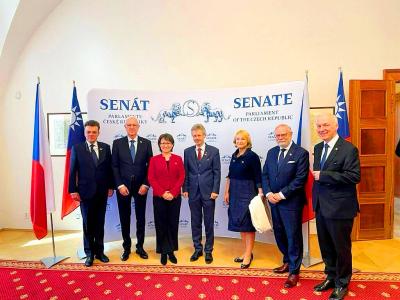Orders worth about US$2 billion for high-tech products and farm produce. Offers of tax incentives for investment. A promise to send 120,000 tourists to Taiwan every year.
Those were some of the deals signed off by a 2,000-strong delegation from China’s Fujian Province during a recent weeklong visit to Taiwan.
It was one of the many buy-Taiwan delegations China has sent over the past year. The visits underscore China’s newly acquired wealth and its immense buying power. They come amid President Ma Ying-jeou’s (馬英九) efforts to promote trade and end decades of cross-strait hostility.
The Fujian delegation, led by the governor and three deputy governors, was by far the largest and attracted constant media coverage, with television cameras following Fujian chief Huang Xiaojing (黃小晶) as he chatted with people on the street, visited high-tech factories and sampled Taiwan’s famed yellow mangoes.
While it is still uncertain whether all of the product orders will be honored — previous Chinese buying trips to Taiwan have not always lived up to their promises — the mission from Fujian underscores China’s interest in leveraging its buying power to achieve political ends.
Chinese President Hu Jintao (胡錦濤) believes that closer economic ties are the best way to move toward that target, and provincial buying trips — combined with a groundbreaking trade pact expected to be signed next month — are viewed as key elements in his strategy.
Huang attended a ceremony in Kaohsiung City for the inaugural cruise by China’s Cosco Star from the Fujian city of Xiamen that carried 300 Chinese passengers, many with the kind of bulging wallets that light up the eyes of Taiwanese merchants and tour operators.
Huang also offered tax incentives for Taiwanese investing in his province’s Haixi Economic Zone, which is modeled after Taiwan’s world-famous high-tech parks.
Working together, he said, the two sides could design and manufacture products that could make an impact all over the world.
During its visit to Taiwan, the Fujian group may have been thinking about unification, but they were careful not to talk too much about it.
“The buy-Taiwan group no doubt had a political purpose, but the Chinese have learned to push their political agenda in a more subtle way,” Democratic Progressive Party (DPP) Legislator Huang Wei-cher (黃偉哲) said.
That may explain why the delegation’s visits to Yunlin and Tainan — the stronghold of the pro-independence DPP — did not produce the kind of violent demonstrations that have marred earlier visits by senior Chinese envoys.
One of its highlights was a gala banquet attended by 106 Fujian town chiefs and other officials as well as their counterparts in Nantou County. With 40 chefs from Fujian doing the cooking, the banquet for 700 people was described by local media as the largest grass-roots exchange ever conducted between Taiwan and China.
On Sunday, a group of Chinese officials and tour operators visited Taipei’s Lin Family Garden and admired its Fujian-style pavilions and houses built in the 1840s by a Taiwanese millionaire, who was among the many immigrating to Taiwan from the Chinese province.
“This is one clear piece of evidence that we have the same roots and should get along well,” said Bao Guozhong, a tour operator from the Fujian capital of Fuzhou.

The Mainland Affairs Council (MAC) today condemned the Chinese Communist Party (CCP) after the Czech officials confirmed that Chinese agents had surveilled Vice President Hsiao Bi-khim (蕭美琴) during her visit to Prague in March last year. Czech Military Intelligence director Petr Bartovsky yesterday said that Chinese operatives had attempted to create the conditions to carry out a demonstrative incident involving Hsiao, going as far as to plan a collision with her car. Hsiao was vice president-elect at the time. The MAC said that it has requested an explanation and demanded a public apology from Beijing. The CCP has repeatedly ignored the desires

Many Chinese spouses required to submit proof of having renounced their Chinese household registration have either completed the process or provided affidavits ahead of the June 30 deadline, the Mainland Affairs Council (MAC) said on Thursday. Of the 12,146 people required to submit the proof, 5,534 had done so as of Wednesday, MAC deputy head and spokesperson Liang Wen-chieh (梁文傑) said. Another 2,572 people who met conditions for exemption or deferral from submitting proof of deregistration — such as those with serious illnesses or injuries — have submitted affidavits instead, he said. “As long as individuals are willing to cooperate with the legal

The Ma-anshan Nuclear Power Plant’s license has expired and it cannot simply be restarted, the Executive Yuan said today, ahead of national debates on the nuclear power referendum. The No. 2 reactor at the Ma-anshan Nuclear Power Plant in Pingtung County was disconnected from the nation’s power grid and completely shut down on May 17, the day its license expired. The government would prioritize people’s safety and conduct necessary evaluations and checks if there is a need to extend the service life of the reactor, Executive Yuan spokeswoman Michelle Lee (李慧芝) told a news conference. Lee said that the referendum would read: “Do

Taiwan's Vice President Hsiao Bi-khim (蕭美琴) said Saturday that she would not be intimidated by the Chinese Communist Party (CCP), following reports that Chinese agents planned to ram her car during a visit to the Czech Republic last year. "I had a great visit to Prague & thank the Czech authorities for their hospitality & ensuring my safety," Hsiao said on social media platform X. "The CCP's unlawful activities will NOT intimidate me from voicing Taiwan's interests in the international community," she wrote. Hsiao visited the Czech Republic on March 18 last year as vice president-elect and met with Czech Senate leadership, including